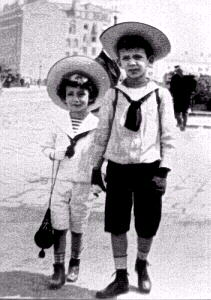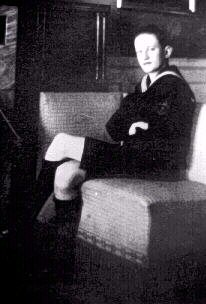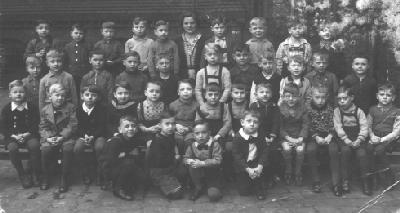
Figure 1.--Sailor-suited German boys going off to school during the 1910s. Motice the wide-brimmed hats.

I have not yet acquired any information on German boys clothing during
these centuries. Presumably it followed the overall European pattern of dressing little
boys in dressesd until they were "breeched" at 4 or 5 years of age. At this
time they would have been dressed in small versions of their father's
clothes. This is, however, speculative on my part and needs to be
confirmed.
I do not have any information on how German boys were dressed in the
early 19th century.
The pattern in other European countries was to develop
special styles of clothing for children. I assume the Germans also moved in this direction. Some of the Empire styles like the skeleton suit
were associated with French fashions so I'm not sure how widely they
were adopted in Germany.

Figure 1.--Sailor-suited German boys going off to school during the 1910s. Motice the wide-brimmed hats. |
The Germans by the end of the century were dressing children in
a similar manner to other European countries. The sailor suit was
one of the most popular styles. The mairage of one of the Queen Victoria's
daugters to the German royal family influenced German fashion, although
she was always considered a foreigner and Bismark limited her influence over
the upbringing of the future Kaiser. I'm unsure as to how other popular
English fashions such as the kilt and Fautleroy suit were in Germany.
Boys' clothing does appear to be similar to the rest of western Europe,
but I hope to eventually obtain much more information on German dress
trends in the future. I do not know of any destinctive German styles
worn by boys, except for folk costumes.
No destinctive German style appeared after the turn of the century. Styles appeared to have followed trends in the rest of Western Europe. Sailor suits remained very popular for boys of all ages. Slowly knee length pants and long stockings were replaced by shorts, albeit long ones. Fautleroy suits were worn, but I'm not sure how widely. Unfortunately I have little information on German clothes during this period, but would greatly appreciate any information visitors to this web site could offer.

Figure 2.--Even older German boys between the two wars (1918-39) wore short pants sailor suits. |
Short pants became the dominate fashion for German boys in the 1920s
as in the rest of Europe. Quite old boys wore short pants although some also wore knickers. Some younger boys would wear
long stockings with
shorts during the winter rather than kneesocks. More so than French and British boys, some
German boys would have a pair of long pants to wear during the winter. German boys did not generally wear
school uniforms.
After the turn of the century and especially after
World War I, German boys were commonly dressed in short trousers.
Often smaller boys did not have any long trousers.
German schools did not have the elaborate school uniforms common in
Britain, but boys commonly wore short pants and knee socks to school, in
some cases quite old boys. Younger boys might wear long over the knee
stockings with shorts as the weather became cooler. Sailor suits were
more popular in Germany in
the 1920s-30s and were not, as in Britain, just worn by little boys.
All Aryan German boys after Hitler assumption to power had to join the Hitler youth. The boys wore brown shirts, as they were initially the

Figure 3.--These German elementary children in the 1930s wear a variety of outfits, but all are in shorts, most with over the knee stockings. One boy wearing knee socks has on sandals. The picture was taken in Breslau in what is now Poland. |
German mothers appear to have been more concerned with the winter than
British mothers. Many older boys had long pants to wear during the
colder winter months. Mothers commonly made the decision as to when it was
cold enough for long trousers. Unlike the smaller boys, older boys did not
commonly wear over the knee stockings with shorts.
Bavarian boys wore lederhosen, short leather pants, during
the summer. They lasted forever and were perfect for rough outdoor wear.
They were worn by sdome boys much as jeans were once worn. The style
spread to other areas of Germany as well.
After 1932 most Aryan German boys had to join the Hitlar Youth. The uniform consisted of a brown shirt, black shorts,
and white kneesocks. There was also a winter long pants uniform.
After the Second World War Germany was devestated. There was little money for clothes. Insights into what German boys were wearing after the War can be seen in some of the many images of the Berlin Air Lift. Children were drawn to the activity at the airports. Pictures of the planes coming into Templehof are often framed with the children watching the flights. American pilots started dropping candy which attracted even more children. Most of the younger boys wears shorts, some suspender shorts. During the warmer months many boys are barefoot or wear ankle socks. Not all boys wear shorts, but most of the younger ones do as well as many older boys. Even some older tenagers can be seen in short pants suits. In the colder months, outfits are more varied. Many boys during the winter wear long pants. There are still many boys in short pants and knee socks, but clearly many mothers decided on warmer long pants for winter wear. Some of the younger boys in shorts during the winter months wear long over the knees stockings. Some boys at the time cleary continued to wear short pants suit until they were older teenagers. Shorts were
German boys' clothes began to change
in the 1960s. One factor was rising income levels. Another was the
development of rebellious teen culture. The trend developed later in
Germany than in America and other western European countries,
but by the 1960s it had arrived. The change was particularly rapid after the
Paris student
strike of 1968. By the 1970s shorts had become increasingly rare
except on younger boys. Little boys still wearing shorts during the winter
might be dressed in long over the knee stockings or in beginning in
the 1950s, tights. Some boys would wear them for warmth under long
pants. Most German boys like other boys in Western
Europe wanted jeans. The change was a slower in Communist Eastern
Germany (DDR). But East Germand received West German (BRD) television
and fashion easily breeched the Iron Curtain.
German boys today dress just like other boys in Western Europe. Short
pants are rarely worn except by younger boys for casual summer wear. German
like other European boys virtually live in jeans.
Navigate the Boys' Historical Clothing German pages:
[Main German page]
[German choirs]
[German scouts]
[Hitler Youth]
[German school uniforms]
[German royalty]
[German sailor suits]
[Lederhosen]
[Tights]
[Long stockings]
[German ethnics]
Navigate the Boys' Historical Clothing Web Site:
[Introduction]
[Chronology]
[Clothing styles]
[Biographies]
[Bibliographies]
[Activities]
[Countries]
[Contributions]
[Boys' Clothing Home]
